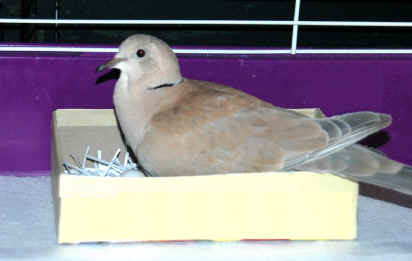
Mourning doves also referred to as turtle doves tend to mate for life. One of those on the list of animals that mate for life actually lives in Brooklyn New York and its a special breed of parrot commonly referred to as Quaker Parrots.

Mating for Life.
Do ring doves mate for life. Do collared doves mate for life. Collared doves are monogamous and can breed continuously in warm regions. When a pair has eggs in the nest the female will incubate the eggs during the day before swapping over at dusk for the male to incubate through the night.
Mourning doves also referred to as turtle doves tend to mate for life. The birds are generally monogamous with both parents working together to care for and incubate the young in their brood. Mourning doves are prolific breeders and raise up to six broods each year in warmer climates.
Yes they mate for life. Doves are called Love Birds for a reason. They sit on a telephone line and kiss and kiss for half an hour.
Thats what we observedBut the one which lost the mate will find another. Studies show mourning doves do mate for life but dove life isnt very long. Most only last several years before getting caught by hawks or cats shot by hunters etc.
And when that happens the. Mourning Doves Mate for Life. Its fairly common to see two mourning doves cuddling with each other.
Mating pairs are monogamous and often mate for life. Another name for them is turtle doves So small wonder that the author of the favorite Christmas song kept them as a pair. In due course the surviving dove will find a new mate.
Since they nest several times a season 2 - 3 is normal its possible they will raise a successful brood in the same season. While its sad to lose these birds in your yard be comforted knowing they will mate again. The average lifespan of first year birds is 1 - 15 years.
FACTS ABOUT MOURNING DOVES. Mourning doves mate for a life. Mourning doves are monogamous birds.
Well everybody likes loyalty. It appears that these humble doves could actually outperform some people in loyalty race. According to the American Dove Association mourning doves stay with their partner for a life or at least until one of them dies.
It takes California Condors highly endangered birds on Audubons Watchlist between six and eight years to reach sexual maturity. Once the birds mate they stay together for years if not for life. During courtship aerial displays bring the pairs to several nest optionskind of.
One of those on the list of animals that mate for life actually lives in Brooklyn New York and its a special breed of parrot commonly referred to as Quaker Parrots. These birds apparently arrived here from Argentina in the late 1960s and early 70s. The Barbary dove is the domesticated form of the collared dove 2.
There are several species of African doves that look very similar to the collared dove including the ring-necked red-eyed and African mourning doves. Bread forms a significant part of the diet of many suburban doves. Mating for Life.
There is a saying the doves mate for life which may be somewhat misleading. They say doves will mate for life unless something occurs that indicates the pair is incompatible or death or injury occurs to one of the pair. In real life that is not completely true.
A graceful slender-tailed small-headed dove thats common across the continent. As I was listening to the weather report Friday April 13 2012 Spotted this. If you allow your ring-necked dove to mate year-round they will be constantly exhausted.
Its usually recommended to take months-long breaks between clutches. Now as doves dont climb up cage bars like parrots for example a ring-necked dove in captivity will require a cage that is wide. Collared doves are a pale pinky-brown grey colour with a distinctive black neck collar as the name suggests.
They have deep red eyes and reddish feet. Their monotonous cooing will be a familiar sound to many of you. Although youll often see them on their own or in pairs flocks may form where there is a lot of food available.
Although they remain faithful for life these birds of prey show constant affection for each other even outside the breeding season with mutual preening and cheek rubbing. As the female lays and incubates her eggs the male remains close does the hunting and over many weeks feeds both his mate and their chicks.